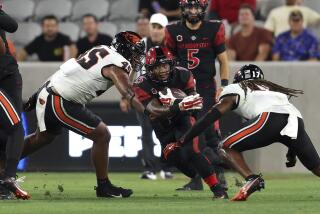A Battered Pac-10’s New Motto: Image Is Everything
- Share via
The media picked Washington to win the Pacific 10 Conference title Thursday and, in a shadow convention tally, predicted the Huskies would finish fourth in the Mid-American Conference.
Give Pac-10 members credit. They’ve taken this kind of guff for almost a year and still show up for work.
Pac-10 football is coming off its worst season since 1983, when a walk-on quarterback led UCLA to the Rose Bowl with a 6-4-1 record.
That kid, Rick Neuheisel, is now coaching Washington, expected to help lead the Pac-10 out of the wilderness.
Hey, what symmetry.
Mediocre then, mediocre now.
Neuheisel’s reaction to his Huskies being picked as favorites?
“I can’t wait to go tell my team that it doesn’t mean anything,” he said at Pac-10 media day.
As if the rest of the country didn’t think that already.
Despite Arizona State’s flirtation with a national title in 1996, and UCLA’s toe-dance two years ago, the Pac-10’s image is lower than dirt.
Last year, on national television, Arizona went to Penn State with a No. 4 preseason ranking and got de-cleated, 41-7. Arizona finished 6-6.
“We contributed greatly to the image of our conference by the way we played at Penn State,” Arizona Coach Dick Tomey said. “We played horribly.”
Well put.
The rest of the Pac-10 followed like lemmings over the nonconference cliff:
Texas 69, Stanford 17.
Nebraska 45, California 0.
Notre Dame 48, Arizona State 17.
Ohio State 42, UCLA 20.
The conference capped the season with a 1-4 bowl record.
“It gave us a sick feeling,” Commissioner Tom Hansen said. “But we have the ability to come back. Now we have to go out and do it.”
This is a put-up year for the conference. As quickly as it turned ugly, the Pac-10 can begin to restore order Aug. 27, when USC meets Penn State in the Kickoff Classic at East Rutherford, N.J.
“It is more than a USC game,” Trojan Coach Paul Hackett said. “It’s about West Coast football and what’s going on with West Coast football.”
Is there reason to believe?
Last year, most of the Pac-10’s tough nonconference games were on the road. This year, the big games are at home. Alabama and Michigan visit UCLA, Colorado and Notre Dame are at USC, Miami is at Washington, Ohio State plays at Arizona and Texas goes to Stanford.
Sept. 9 shapes up as one of the most important days in recent conference history: Ohio State at Arizona, Oregon at Wisconsin, Utah at Cal, Colorado at USC, Miami at Washington, Fresno State at UCLA, San Jose State at Stanford and Oregon State at New Mexico.
“We have a chance to win more of the same games because they’re at our sites,” Hansen said.
You can argue all day about why the conference hasn’t had a consensus national champion since the 1972 USC Trojans.
You can start with the Trojans, once a national powerhouse, who have drifted from a punishing run-oriented program to a passing team.
“Penn State looks like the USC teams of old,” Hackett said. “That’s something we aspire to be.”
Now there’s a quote you won’t find in the recruiting brochure.
In recent years, the Pac-10 has become a skeleton league. With 217, it still has more players on NFL rosters than any other conference, but the Pac-10 no longer produces enough beefy interior players to consistently match traditional powers from the Big Ten and Southeastern conferences.
What to do? To stop up-tempo Pac-10 offenses, coaches have to recruit quick defenders.
“Our accent is on speed,” Neuheisel said.
Is winning nonconference games more important than the league title?
Should the Pac-10 start signing more 350-pound nose tackles?
“Not at the exclusion of the other,” Neuheisel said.
The Pac-10 needs a bounce-back year to stem further erosion.
People are talking and players are fleeing.
D.J. Williams, the nation’s top player out of Concord’s De La Salle High in the Bay Area, signed to play in Miami.
“It’s happening more and more,” Washington State Coach Mike Price complained. “Heck, we had a player from Seattle go to Duke. Hell, we got trains up here if he wanted to be an engineer.”
Get this: Price coached Drew Bledsoe, who played at Walla Walla High. You’d think Price would have a shot at any other quarterback out of Walla Walla, right?
Wrong. Not only did Jared Jones sign with Florida State, he did not even pay a recruiting visit to Washington State.
It has gotten so bad coaches have hailed as a recruiting breakthrough the fact conference athletic directors have approved legislation to provide Pac-10 athletes year-round training table--common in most major conferences.
This will allow players to gorge on fatty starches 12 months a year.
“From a perception standpoint, training table has been almost an albatross around the neck of the league,” Neuheisel said.
What kind of coach would use training table as a recruiting tool against the Pac-10?
Well, Neuheisel, for one.
“I was guilty of it at Colorado,” he said of the ploy. “We’d say we can feed your kid all year round. That’s part of selling.”
It doesn’t take long to change a perception.
On an L.A. reporter’s recent visit to Texas, Longhorn quarterback Major Applewhite greeted him with the quip, “They play football out there?”
Reminded that UCLA defeated Texas, 66-3, three years ago, Applewhite blanched.
Oh, yeah, remember that?
(BEGIN TEXT OF INFOBOX / INFOGRAPHIC)
Pacific 10 at a Glance
1999 FINAL STANDINGS
1. Stanford: 7-1 (8-3)
2. Oregon: 6-2 (8-3)
3. Washington: 6-2 (7-4)
4. Arizona State: 5-3 (6-5)
5. Oregon State: 4-4 (6-4)
6. Arizona: 3-5 (6-6)
7. USC: 3-5 (6-6)
8. California: 3-5 (4-7)
9. UCLA: 2-6 (4-7)
10. Washington St.: 1-7 (3-9)
*
2000 PREDICTIONS
(by West Coast Media)
Team Returning Starters
1. Washington: 15
2. USC: 15
3. Oregon: 9
4. UCLA: 15
5. Arizona State: 13
6. Oregon State: 15
7. Stanford: 12
8. Arizona: 11
9. California: 13
10. Washington State: 14
*
CONFERENCE RANKINGS
(1999, by Jeff Sagarin)
Conference Bowl Record
1. Big Ten: 5-2
2. Southeastern: 4-4
3. Atlantic Coast: 2-3
4. Big 12: 3-3
5. Pacific 10: 1-4
6. Mountain West: 1-2
7. Big East: 2-2
8. Conference USA: 1-2
9. Western Athletic: 2-1
10. Big West: 1-0
More to Read
Go beyond the scoreboard
Get the latest on L.A.'s teams in the daily Sports Report newsletter.
You may occasionally receive promotional content from the Los Angeles Times.







